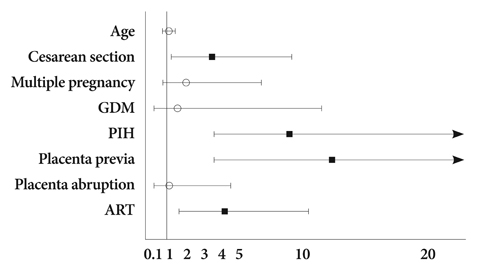Korean Circ J.
2011 Jan;41(1):23-27. 10.4070/kcj.2011.41.1.23.
Pregnancy-Induced Hypertension, But Not Gestational Diabetes Mellitus, Is a Risk Factor for Venous Thromboembolism in Pregnancy
- Affiliations
-
- 1Division of Medicine/Cardiology, Cheil General Hospital, Kwandong University, College of Medicine, Seoul, Korea. mdparkjb@gmail.com
- KMID: 2225150
- DOI: http://doi.org/10.4070/kcj.2011.41.1.23
Abstract
- BACKGROUND AND OBJECTIVES
The aim of this study was to identify the association of pregnancy-induced hypertension (PIH) or gestational diabetes mellitus (GDM) with the development of venous thromboembolism (VTE).
SUBJECTS AND METHODS
This was a retrospective study of 57,009 pregnancies during 2002-2008 at Cheil General Hospital, Kwandong University. The diagnosis of VTE {deep vein thrombosis or pulmonary embolism (PE)} was based on clot visualization via ultrasound or computed tomography.
RESULTS
In total, 27 cases (PE, 20 cases) were detected. The incidence of VTE was 0.47 per 1,000 pregnancies. To determine risk factors associated with pregnancy-induced VTE, univariate analysis using a chi-square test was performed. Cesarean (C)-section, multiple pregnancy, PIH, placenta previa, and assisted reproduction technique (ART) were statistically significant compared to the controls (all, p=0.000). However, age, premature rupture of membrane, and GDM were not statistically related to VTE. Logistic regression analysis was used to calculate the odds ratios for the risk factors. Placenta previa showed a 12.6-fold higher risk, while PIH had a 9.8-fold higher risk for the occurrence of VTE. C-section and ART procedures increased the risk of VTE by 4.2 times compared to that of the controls.
CONCLUSION
Placenta previa and PIH were significant risk factors for VTE, whereas the known traditional risk factors of increased age and GDM were not found to be associated with VTE.
MeSH Terms
Figure
Cited by 1 articles
-
Thromboembolism in pregnancy
Joon Cheol Park
J Korean Med Assoc. 2016;59(1):8-13. doi: 10.5124/jkma.2016.59.1.8.
Reference
-
1. Jacobsen AF, Skjeldestad FE, Sandset PM. Incidence and risk patterns of venous thromboembolism in pregnancy and puerperium: a register-based case-control study. Am J Obstet Gynecol. 2008. 198:233.e1–233.e7.2. Marik PE, Plante LA. Venous thromboembolic disease and pregnancy. N Engl J Med. 2008. 359:2025–2033.3. Greer IA. Thrombosis in pregnancy: maternal and fetal issues. Lancet. 1999. 353:1258–1265.4. Moon HJ, Rhim CY, Kim GW, et al. Risk factors of deep vein thrombosis and pulmonary embolism in Korean. Korean Circ J. 2005. 35:474–479.5. Kim KY, Moon KW, Jeon DS, et al. A case of hereditary antithrombin III defiency manifestation of infarct and deep vein thrombosis. Korean Circ J. 2002. 32:521–525.6. Lee SW, Seo HS, Ghil JH, Rim SJ, Kang SM, Chung NS. A case of internal Jugular vein thrombosis after in vitro fertilization. Korean Circ J. 2004. 34:214–219.7. Lindqvist P, Dahlback B, Marsal K. Thrombotic risk during pregnancy: a population study. Obstet Gynecol. 1999. 94:595–599.8. Ros HS, Lichtenstein P, Bellocco R, Petersson G, Cnattingius S. Pulmonary embolism and stroke in relation to pregnancy: how can high-risk women be identified? Am J Obstet Gynecol. 2002. 186:198–203.9. Report of the National High Blood Pressure Education Program Working group report on high blood pressure in pregnancy. Am J Obstet Gynecol. 2000. 183:S1–S22.10. Cheung NW, Byth K. The population health significance of gestational diabetes. Diabetes Care. 2003. 26:2005–2009.11. James AH, Jamison MG, Brancazio LR, Myers ER. Venous thromboembolism during pregnancy and the postpartum period: incidence, risk factors, and mortality. Am J Obstet Gynecol. 2006. 194:1311–1315.12. Heit JA, Leibson CL, Ashrani AA, Petterson TM, Bailey KR, Melton LJ 3rd. Is diabetes mellitus an independent risk factor for venous thromboembolism? Arterioscler Thromb Vasc Biol. 2009. 29:1399–1405.13. Carpenter MW, Coustan DR. Criteria for screening tests for gestational diabetes. Am J Obstet Gynecol. 1982. 144:768–773.14. Koonin LM, MacKay AP, Berg CJ, Atrash HK, Smith JC. Pregnancy-induced mortality surveillance: United States, 1987-1990. MMWR CDC Surveill Summ. 1997. 46:17–36.15. Brill-Edwards P, Ginsberg JS, Gent M, et al. Safety of withholding heparin in pregnant women with a history of venous thromboembolism. N Engl J Med. 2000. 343:1439–1444.16. Pabinger I, Grafenhofer H, Kaider A, et al. Risk of pregnancy-associated recurrent venous thromboembolism in women with a history of venous thrombosis. J Thromb Haemost. 2005. 3:949–954.17. Royal College of Obstetricians and Gynaecologists (RCOG). Thromboprophylaxis during pregnancy, labour and after vaginal delivery. Guideline No. 37. 2004. London: RCOG Press.18. Royal College of Obstetricians and Gynaecologists (RCOG). Report of the Royal College of Obstetricians and Gynaecologists (RCOG) working party on prophylaxis against thromboembolism in gynaecology and obstetrics. 1995. London: RCOG Press.19. Gherman RB, Goodwin TM, Leung B, Byrne JD, Hethumumi R, Montoro M. Incidence, clinical characteristics, and timing of objectively diagnosed venous thromboembolism during pregnancy. Obstet Gynecol. 1999. 94:730–734.20. Kestenbaum B, Seliger SL, Easterling TR, et al. Cardiovascular and thromboembolic events following hypertensive pregnancy. Am J Kidney Dis. 2003. 42:982–989.21. Roberts RN, Henriksen JE, Hadden DR. Insulin sensitivity in pre-eclampsia. Br J Obstet Gynaecol. 1998. 105:1095–1100.22. Morris NH, Eaton BM, Dekker G. Nitric oxide, the endothelium, pregnancy and pre-eclampsia. Br J Obstet Gynaecol. 1996. 103:4–15.23. Tsai AW, Cushman M, Rosamond WD, Heckbert SR, Polak JF, Folsom AR. Cardiovascular risk factors and venous thromboembolism incidence. Arch Intern Med. 2002. 162:1182–1189.24. Petrauskiene V, Falk M, Waernbaum I, Norberg M, Eriksson JW. The risk of venous thromboembolism is markedly elevated in patients with diabetes. Diabetologia. 2005. 48:1017–1021.25. Ageno W, Becattini C, Brighton T, Selby R, Kamphuisen PW. Cardiovascular risk factors and venous thromboembolism: a meta-analysis. Circulation. 2008. 117:93–102.26. James AH. Thromboembolism in pregnancy: recurrence risks, prevention and management. Curr Opin Obstet Gynecol. 2008. 20:550–556.27. Santoro R, Iannaccaro P, Prejanò S, Muleo G. Efficacy and safety of the long-term administration of low-molecular-weight heparins in pregnancy. Blood Coagul Fibrinolysis. 2009. 20:240–243.28. Spyropoulos AC, Turpie AG, Dunn AS, et al. Clinical outcomes with unfractionated heparin or low-molecular-weight heparin as bridging therapy in patients on long-term oral anticoagulants: the REGIMEN registry. J Thromb Haemost. 2006. 4:1246–1252.


